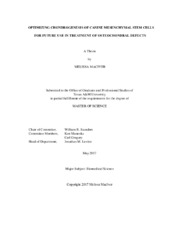| dc.description.abstract | Osteochondrosis and traumatic osteochondral defects are debilitating disorders affecting articular cartilage of millions of human and veterinary species. As articular cartilage is highly specialized and lacks reparative capacity, focal osteochondral defects (FODs) lead to a chronic progressive disease state and subsequent widespread osteoarthritis. While medical and surgical management options are available, they are not without complications. To address these limitations, recent work in the field of regenerative medicine has focused on the use of mesenchymal stem cells (MSCs) and three-dimensional (3D) scaffolds to develop tissue engineering constructs to replace injured articular cartilage restoring function and eliminating clinical signs. While much work has been performed in human MSC tissue engineering, canine MSC (cMSC) tissue engineering for the treatment of osteochondral defects remains in its infancy. The objective of the work presented herein was to develop an improved 3D serum free system for cMSC chondrogenesis and determine the effect of dose and combination of three important chondrogenic growth factors (TGF-β3, BMP-2 and bFGF) using bone marrow-derived cMSCs.
During phase 1, the effect of ten growth factor combinations on cMSC chondrogenesis was determined using construct morphometry, live/dead staining, and histology. High doses of BMP-2 and bFGF produced heavier, larger, consistently shaped constructs when compared to lower doses. Based on these results, in phase 2, the effect of dexamethasone, TGF-β3, and high concentrations of BMP-2, and bFGF were assessed using quantitative assays of cytotoxicity, glycosaminoglycan (GAG) accumulation, and gene transcription. In the presence of bFGF, evidence of reduced cell stress suggested a potential role in cell survival during initial stages of chondrogenesis when the cells initiate a condensation event. Moreover, the presence of BMP-2 and bFGF in chondrogenic media resulted in the highest accumulation of GAG. Gene expression studies demonstrated that upregulation of genes associated with chondrogenesis and osteogenesis occurred in a time-dependent manner. Ultimately, this work demonstrates that the 3D serum-free collagen type I system described is useful for assessing canine chondrogenic differentiation. Collectively, this work describes the effect of chondrogenic growth factors on cMSCs in combination with a 3D collagen type I scaffold and represents an important advance in canine chondrogenesis. | en |


